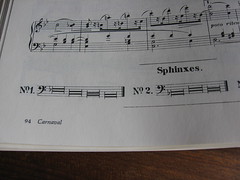
At intermission, most people spill from the
Paris Opera clutching their already-lit cigarettes, but a few drift to the front row to peer into the orchestra pit while the musicians arrange their set-ups. Two-thirds of the way through the
Merce Cunningham Dance Company's program, Christian Wolff reshuffles his pages of John Cage's ASLSP,
William Winant puts away instruments from his array of percussion, and
Takehisa Kosugi prepares the electronics for the final piece of the evening. An English-speaking couple bravely toss a question into the pit, "so...what was that last piece
about?" which the musicians acknowledge with knowing smiles. "Hmm...Merce's work isn't necessarily about something; it's not really telling a story," Winant begins, "but...well, the next piece is much different. You might prefer it to...but why don't you ask
her? I think she has some ideas." (I must admit I love it when performers retain a certain guarded secrecy about the "meaning" of their work and leave these riddles in the hands and ears of others.)
Having seen the program a number of times during the company's week-long run at the Opera, I feel quite authoritative explaining that Cunningham's work avoids a narrative quality; rather the dance is "about" pure movement. In watching the movement closely--an arm position, a pattern of tendus and passés, a leap or collapse of body weight--one finds the "about," the translation. There is a clear angularity to Cunningham's work, as when the dancers perform the same precise movements but at different facings to the audience. The effect is particularly powerful when the mirrored steps occur between a pair of dancers; you clearly recognize the unison of movement though the dancers occupy various planes of space. When I watch this dance, I feel as if I am turning an intricate gemstone in my hand; I see all the sides at once...the facets unfold in my palm. It is a simple (and admittedly abstract) statement yet enough to satisfy my need for meaning.
Every element of Cunningham's work is consciously chosen, from the costumes and sets to the movement and music. Unlike more classical dance, where the components all work together to create and heighten our awareness of a story, here each element offers itself simply, purely, in and of itself. Of course, with design by the likes of Robert Rauschenberg or Jasper Johns (not to mention Ernesto Neto's dripping, bulbous, purply-violet lit sculpture for "Views on Stage" as presented here at the Paris Opera), and music composed and/or performed by the inimitable John Cage, David Tudor, Winant or Wolff, there is almost an overwhelming amount of sensory information for the viewer to consider. Unlike the great romantic ballets, where the orchestra, costumes, and corps de ballet
accompany and support the prima ballerina and the grand pas de deux, the Cunningham stage is a good-natured competition of equally important media. When intersections or simultaneities between media occur, the viewer may begin to read and comprehend the piece as a whole, even though this comprehension is unique to each individual. The dynamic relationships of one dancer's movements to another, or of movements against or with the music, all become expressive, emotive, and suggestive. No translation necessary.
We demand translation but too often of the wrong thing. In traditional opera, musical theatre, or popular song, communication is direct and immediate, with text that allows us to map our lives onto fictional ones. We easily comprehend meaning in instrumental music, too: the constructs of traditional western harmony, melody, and even rhythm create (like it or not) expectancy, hesitation, hope and surprise...urgency, resolution, satisfaction and satedness. With the mid-twentieth century abandonment of these systems, the role of "translator" passed from the musical or extra-musical source--melody or harmony, libretto or lighting--into the hands of the performer. In Cunningham's work, for example, while the movement is not meant to translate into a story, it does reveal the dancers' technical prowess and committment to creating lines in space--for whatever those lines may mean. The company are fearless, almost perfect, every muscle committed to the choreography (not to acting or creating character with facial expressions, etc.). It is their precision and virtuosity that allows me to "read" the dance even though modern dance is not my language. The delivery--the performance--is all the "about" that I need. Like Denise Acabo, whose whole-hearted enthusiasm for her chocolates successfully erradicated a language barrier, a performer can turn a suggestion into precise meaning.
As an audience, we must be responsive to the contemporary emphasis on the performer. Though I usually find much meaning in the Cunningham company's performance, I also realize that I watch the performance for its performative qualities: the conviction of gesture and a committment to physical phrasing. If those elements seem sub-par on a given night, then I might criticize the dance for its lack of being "about" something. The dance, as language, is confusing to me only when the performance lacks a certain devoted intensity.
From the furrowed foreheads of the English-speaking couple, I fear my explanation has only muddled matters. So, sighing, I say, "but you might really enjoy the last piece. It is almost more of a story, beginning and ending with one whirling man...very un-Cunningham to me, but you might prefer it to this last piece. It is, in a way, more immediately accessible." More immediately...translated.
continue reading...






